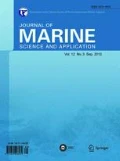Abstract
The development of damage detection techniques for offshore jacket structures is vital to prevent catastrophic events. This paper applies a frequency response based method for the purpose of structural health monitoring. In efforts to fulfill this task, concept of the minimum rank perturbation theory has been utilized. The present article introduces a promising methodology to select frequency points effectively. To achieve this goal, modal strain energy ratio of each member was evaluated at different natural frequencies of structure in order to identify the sensitive frequency domain for damage detection. The proposed methodology opens up the possibility of much greater detection efficiency. In addition, the performance of the proposed method was evaluated in relation to multiple damages. The aforementioned points are illustrated using the numerical study of a two dimensional jacket platform, and the results proved to be satisfactory utilizing the proposed methodology.
Similar content being viewed by others
References
Carden EP, Fanning P (2004). Vibration based condition monitoring: a review. Structural Health Monitoring, 3(4), 355–377.
Carrion FJ, Doyle JF, Lozano A (2003). Structural health monitoring and damage detection using a sub-domain inverse method. Smart Mater. and Struct., 12, 776–784.
Golafshani AA, Kianian M, Ghodrati E (2010). Health monitoring of structures using few frequency response measurements. Scientia Iranica, 17(6), 493–500.
Hwang HY, Kim C (2004). Damage detection in structures using a few frequency response measurements. Journal of Sound and Vibration, 270, 1–14.
Kaouk M, Zimmerman DC (1994). Structural damage assessment using a generalized minimum rank perturbation theory. AIAA J, 32(4), 836–842.
Li H, Wang J, Hu SLJ (2008). Using incomplete modal data for damage detection in offshore jacket structures. Ocean Engineering, 35, 1793–1799.
Maia NMM, Silva JMM, Almas EAM (2003). Damage detection in structures: from mode shape to frequency response function methods. Mechanical Systems and Signal Processing, 17(3), 489–498.
Yan YJ, Cheng L, Wu ZY, Yam LH (2007). Development in vibration-based structural damage detection technique. Mechanical Systems and Signal Processing, 21, 2198–2211.
Zimmerman DC (2006). Statistical confidence using minimum rank perturbation theory. Mechanical Systems and Signal Processing, 20, 1155–1172.
Zimmerman DC, Kaouk M (1994). Structural damage detection using a minimum rank update theory. ASME Journal of Vibration and Acoustics, 116(2), 222–231.
Zimmerman DC, Simmermacher T, Kaouk M (1995). Structural damage detection using frequency response functions. Proceedings of 13th International Modal Analysis Conference, Nashville, TN, 179–184.
Zimmerman DC, Simmermacher T, Kaouk M (2005). Model correlation and system health monitoring using frequency domain measurements. Structural Health Monitoring, 4(3), 213–227.
Author information
Authors and Affiliations
Additional information
Foundation item: Financial Support by the Pars Oil and Gas Company (Grant No. 88-065).
Morteza Kianian graduated from the KNT University, Tehran, Iran, in 2007 with a B.S. degree in civil engineering. He continued post graduate studies in the field of hydraulic structures at Sharif University of Technology (SUT), Tehran, Iran, and graduated in 2010 with a M.S. degree. Since 2010 he has been cooperating with Iranian Marine Industrial Company as a structural designer of offshore jacket structures. His research interests include: structural dynamics, structural health monitoring, offshore structures and base isolation.
Ali Akbar Golafshani graduated in 1978 from Utah State University, Logan, USA with a B.S. degree. He continued post graduate studies in the field of structural mechanics at the University of California, Berkeley, USA, and graduated in 1981 with a Ph.D degree. Since 1982, he has been cooperating with Sharif University of Technology (SUT) as a Professor in the Department of Civil Engineering, Dean of Civil Engineering Department and Head of Earthquake Engineering Research Center. He also served as director of Engineering in Iranian Offshore Oil Company (IOOC) and Oil Industries Engineering and Construction (OIEC) for many years.
Emad Ghodrati graduated from the University of Tehran in 2005 with a B.Sc. degree in civil engineering. Then, He took the nationwide Graduate entrance exam, where he ranked 2nd among more than 13000 participants, and was admitted to the Sharif University of Technology (SUT). He graduated in 2007 with a M.Sc. degree in structural engineering. He is now Ph.D candidate at the Department of Civil and Environmental Engineering at the University of Utah, Salt Lake City, USA.
Rights and permissions
About this article
Cite this article
Kianian, M., Golafshani, A.A. & Ghodrati, E. Damage detection of offshore jacket structures using frequency domain selective measurements. J. Marine. Sci. Appl. 12, 193–199 (2013). https://doi.org/10.1007/s11804-013-1185-y
Received:
Revised:
Published:
Issue Date:
DOI: https://doi.org/10.1007/s11804-013-1185-y



